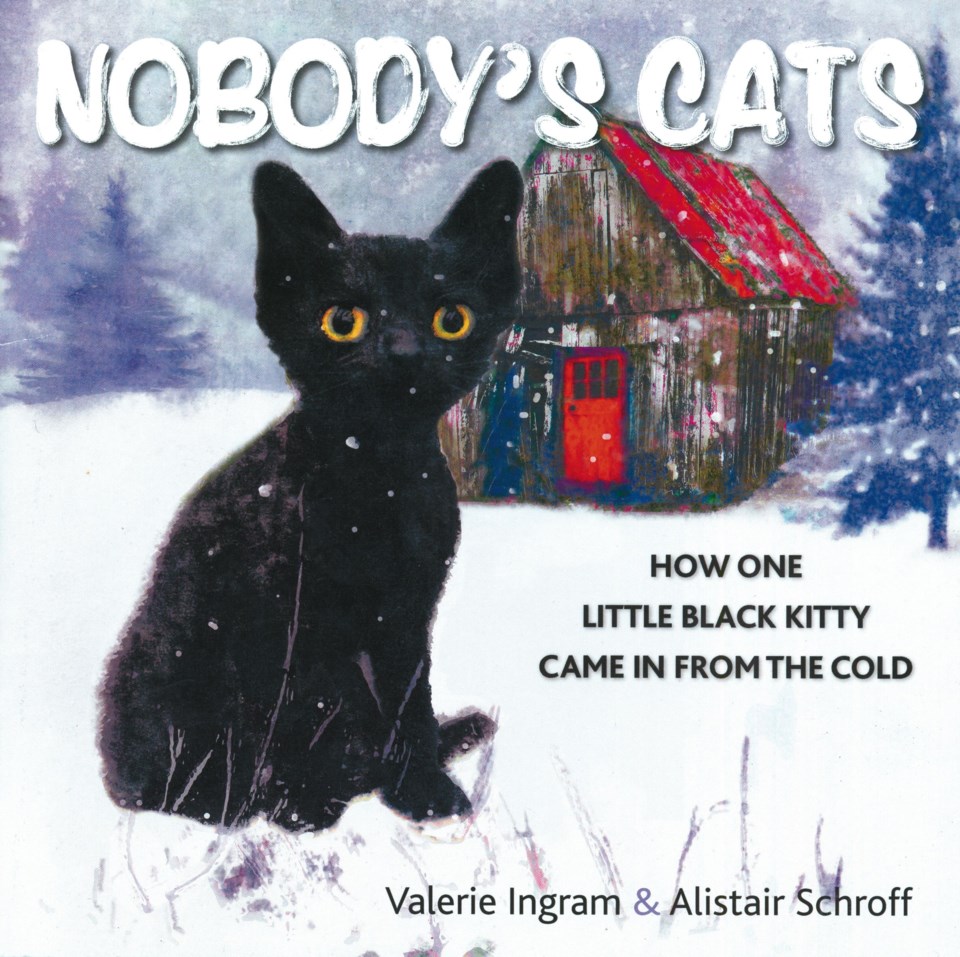A little black kitty got saved by a community rescue effort, and now that little black kitty is saving other animals.
The little black kitty in question was the first in a sweeping campaign to spay, neuter and adopt out as many wild cats in the Lakes District as the community could manage. It had such an emblematic personal story that this feral feline became the basis of a new children's book called Nobody's Cats - How One Little Black Kitty Came In From The Cold.
The book was written by Valerie Ingram and Alistair Schroff, the couple that operates the Lakes Animal Friendship Society (LAFS). The book is a fundraiser for their not-for-profit organization.
"Nobody's Cats is based on the true story of a project to help community cats in our area," said Ingram. "Two girls, Vivienne and Catrina, saw suffering cats near their home one winter."
It was an ever-growing colony of feral cats barely eking out survival in an abandoned shed. There were no owners or caretakers for any of these cats.
The girls took their observations to their school and to LAFS asking for help. They raised $100 mostly via Grassy Plains Elementary School, and committed to keeping a supply of food at the shed so the animals would at least not starve to death over winter.
"The colony was typical of many situations: two stray cats showed up in the neighbourhood and soon there were dozens of cats - far too many for anyone to take care of without help. Over the years, many cats there died or were killed. The caregivers of this colony loved cats, but the population was out of control."
The $100 and the girls' spirit inspired LAFS, the community and eventually funders like the BC-SPCA, PetSmart Charities Of Canada and Lakes District Maintenance. The area's veterinarian, Dr. Lois Martin, and the Cheslatta Carrier Nation also joined forces.
LAFS led a live capture campaign at the colony site. Some, with the help of Simonds' Sanctuary and Prince George Petland, the cats were adopted to permanent homes, but, said Ingram, there were too many cats by far for homes to be located. The majority were returned to the colony. But with a difference. They had been spayed or neutered, they were vaccinated against diseases, and they had their left ear marked so the campaign wouldn't mistake which ones had been dealt with and which had not. They may not be able to remove them all, but they could keep them alive by feeding the cats as a group and the population would stop expanding.
"After many visits to the site, we succeeded in spaying and neutering all of the cats. At long last, the crisis had ended," said Ingram.
Thanks to the intervention of Vivienne and Catrina, many more cats than the one colony at the abandoned shed got this help.
"In two years, the project helped just over 400 cats in colonies around our small community, bringing the population under control in colonies where the situation seemed hopeless," Ingram said. "The cats that remain are healthier, and there is no more worry about hundreds of kittens being born each year to live short, tough lives. The colonies will be monitored to make sure they stay healthy, happy and under control."
The LAFS (with the financial help of the Canadian Animal Assistance Team or CAAT) has facilitated more than 1,000 spays/neuters, conducted more than 5,000 student visits to foster animal care awareness in youth, provided more than 200 dog/cat houses for families in need, and channeled through the Burns Lake food bank more than five tonnes of pet food for the animals of families in financial pinch.
The LAFS has been operational for about eight years (five as an approved society). The new book will be distributed free of charge to many elementary schools of the region, and is for sale for $10 via direct contact with LAFS (250-694-3696). A humane group in Pennsylvania just bought 50 of them for education there, and Schroff and Ingram were invited to Arizona to present the book at a conference for animal welfare organizations.
Ingram, a former teacher, finds the book has taken her elementary school guest presentations to a new level.
"In the animal welfare field we find the educational part is often missed," she said. "We see a lot of volunteers out doing great work, but the part that is lost is teaching the public about these issues. I'm so grateful to the schools that they let me in to talk about it, and the book makes it more meaningful. I am seeing changes in attitude and changes in behavior and that is, I think, why that's happening. If you know better, you do better."



